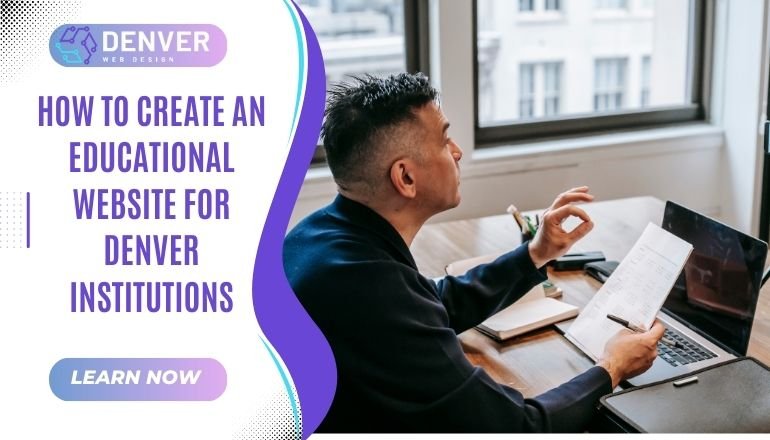
In the digital age, educational institutions in Denver need a robust online presence to effectively serve students, parents, and educators. Creating a functional and engaging educational website involves a combination of best practices in web design, responsive web design, and advanced development techniques. With a user-centered approach, an educational website can address challenges like accessibility, engagement, and information dissemination.
This guide explains how to create a successful educational website for Denver institutions, with insights from Web Design Denver to help you craft an exceptional platform.
What Is an Educational Website?
An educational website is a digital platform designed to provide learning resources, institutional information, and communication tools for its users. Unlike standard business websites, educational sites require unique features to cater to diverse audiences, such as students, teachers, parents, and administrators.
Key Features of Educational Websites
- User-Friendly Navigation: Ensures quick access to information like schedules, course materials, and contact details.
- Responsive Web Design: Optimized for seamless viewing on any device, including tablets and smartphones.
- Content Management System (CMS): Allows easy updates to content like announcements, events, and curriculum changes.
- Interactive Features: Tools like discussion forums, e-learning modules, and virtual classrooms foster engagement.
Educational websites built with custom web design ensure that every feature aligns with the institution’s goals and user needs.
Why Is an Educational Website Essential for Denver Institutions?
Denver institutions, from K-12 schools to universities, operate in a fast-evolving landscape where digital platforms play a crucial role in learning and communication. Here’s why an educational website is vital:
1. Enhanced Accessibility and Communication
Websites bridge the gap between institutions and their audiences. Parents can access school updates, students can view assignments, and teachers can share resources—all from a centralized platform.
2. Improved User Experience (UX)
An educational website designed with UX principles ensures smooth navigation, fast loading times, and clear information, making it easier for users to find what they need.
3. Support for Remote Learning
The rise of e-learning makes online platforms indispensable. Features like virtual classrooms, online assignments, and video lessons enhance remote learning experiences.
4. Increased Credibility
A well-designed website reflects professionalism and builds trust among students and parents. It serves as a public face for the institution.
5. SEO Benefits for Visibility
Optimized websites rank higher on search engines, making it easier for prospective students to discover your institution. SEO for websites ensures Denver institutions stay competitive in the education sector.
Key Features/Components of an Educational Website
1. Intuitive Design and Navigation
Educational websites must be structured logically to accommodate diverse users. Clear menus, search functionality, and categorized content make navigation effortless.
2. Responsive Web Design
With users accessing websites on multiple devices, a mobile-friendly design is non-negotiable. Implement mobile-first design principles to ensure seamless user experiences.
3. Secure Portals for Stakeholders
Private portals for students, parents, and staff allow secure access to grades, attendance records, and other sensitive data.
4. Interactive Tools
Incorporate features like live chat, discussion boards, and calendars to promote interaction and engagement.
5. Multimedia Integration
Videos, images, and downloadable resources like PDFs enhance the learning experience.
6. Scalable CMS
Choose a CMS that supports scalability as the institution grows. Systems like WordPress or Drupal are ideal for managing dynamic educational websites.
Best Practices for Creating Educational Websites
1. Focus on User Needs
Identify the needs of your target audience and prioritize functionality accordingly. For example, parents might need quick access to event calendars, while students benefit from e-learning tools.
2. Optimize for Speed and Performance
Ensure fast page load times by compressing images, using efficient coding, and enabling caching. A slow website can deter users.
3. Invest in SEO Optimization
Use location-specific keywords like “Denver educational websites” to target local audiences. Optimize metadata, content, and structure to improve search rankings.
4. Incorporate Accessibility Standards
Design your website to comply with Web Content Accessibility Guidelines (WCAG), ensuring usability for people with disabilities.
5. Test Regularly
Conduct usability tests to identify issues and make improvements. Regular maintenance ensures a smooth user experience.
Common Mistakes to Avoid
1. Overloading the Design
Cluttered designs with too many elements can confuse users. Focus on simplicity and clarity.
2. Neglecting Mobile Users
Failing to implement a responsive design alienates mobile users, who form a significant portion of website traffic.
3. Ignoring Security
Educational websites often store sensitive data. Implement SSL certificates and robust cybersecurity measures.
4. Outdated Content
Regularly update the website to keep it relevant. Stale or incorrect information can erode trust.
Conclusion: Key Takeaways
Building an educational website for Denver institutions involves more than just creating a digital presence. It’s about crafting a functional, engaging, and scalable platform that meets the needs of students, parents, and educators. Incorporate features like responsive design, interactive tools, and SEO optimization to create a successful website.
If you’re looking for a partner to bring your vision to life, Web Design Denver specializes in creating custom websites tailored to the unique needs of educational institutions. Start your journey toward a cutting-edge educational website today!






